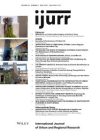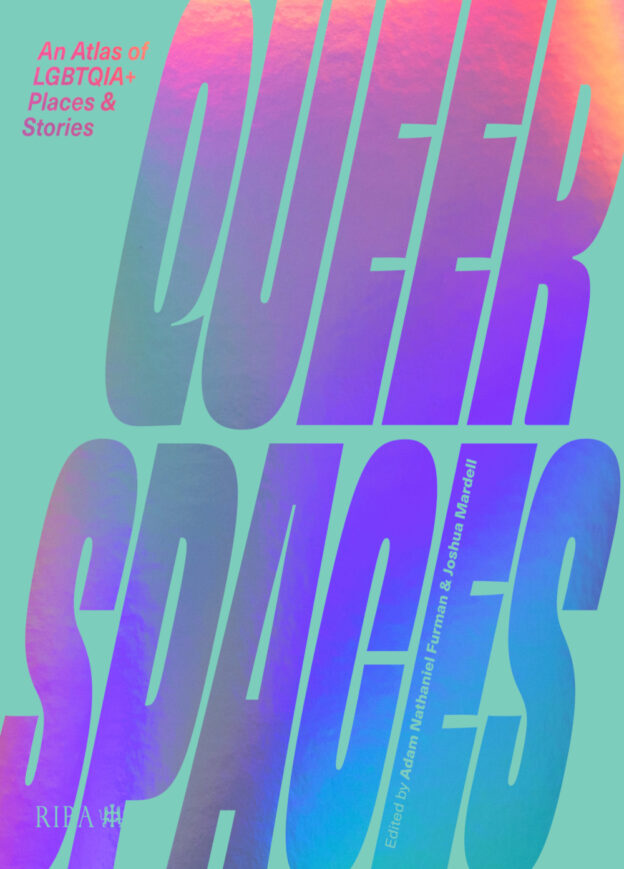What makes a space queer? The challenge of this question is thrown down right from the get-go in the first of the 94 case studies covered in this dazzling compendium. This contribution discusses a train journey through Catalunya during which a trans woman transforms herself, queering with her bodily presence a space which would not ordinarily be seen as queer. In a predominantly heteronormative world, queer spaces are ones which queer people can inhabit without the need to edit themselves. In a world where LGBTQIA+ sex remains routinely policed and is widely illegal, these are often marginal or private spaces wherein illicit encounters can occur. Yet spaces can also be queered by a radical appropriation, challenging the authorized public space discourse of what can or cannot be done through performative repurposing that queers the normative spatial narrative. These different types of queer space are all well-represented in this excellent, lavishly illustrated collection.
Queer spaces are thus defined by exclusion and the consequent adaptation and appropriation that exclusion requires of queer communities. Historically, such liminal spaces have always occurred, not least for sex. The poor, frequently unable to use crowded homes for such purposes, have had to create their own. Their histories are often under-researched, and the inclusion here of the Norfolk Arms in 1950s Sheffield offers a rare example of such a meeting-place receiving detailed analysis. The monied, in contrast, have been able to create private spaces for such encounters. Horace Walpole’s gothic confection of Strawberry Hill was an influential example. Although not included in this collection, it is referenced through the tribute paid to it in the entry on Lee Priory. Built in 1800 (though no longer extant), Lee Priory is one of the oldest entries in a book which concentrates largely on twentieth-century and contemporary spaces which can be identified as queer, whether purpose-designed, adapted or appropriated.
Much effort has gone into ensuring that this work is as global as possible in its coverage and as comprehensive as possible in terms of the variety of LGBTQIA+ experiences and communities presented, both with regards to the spaces highlighted and the voices of the contributors who explain their nature and queerness. It is structured according to types of spaces: domestic, communal and public. As queering represents a political act of challenging conformity to oppressive social norms, it might be argued that some of the spaces represented in the first category can only be read to a limited extent as queer. Yet—not least in historical terms—they often reflect a closeting of queer encounters and a desire to see but not be seen, expressed most radically in Japan’s ‘Light Coffin’ (p. 8). Some of these case studies look generically at how particular groups create their own domestic space and manage their own safety within often hostile environments, such as the discussion of hijra housing in Bangladesh (p. 22).
The second part covers a multitude of communally appropriated spaces and queer activities and activism around them. Toilets are one obvious example, including one of the first documented examples of trans activism in response to the bombing of a urinal in which trans sex workers—excluded from other sectors of the labour market—plied their trade in Barcelona in 1933 (p. 64). In addition to such places for queer sex, including bathhouses (p. 82), there are lots of examples of bookshops, cafés, community centres, theatres, night-clubs and bars, not to mention one office suite, where queer groups can/could meet communally; at least until repressive policing, funding cuts, rapacious landlords or redevelopment closes them down.
The third section covers queerness in public spaces, including Amsterdam’s Homomonument (p. 178) as an example of one of the few acts of LGBTQIA+ memorialization. Some of the case studies in this section, such as the short-lived Sappho Islands bar in Kampala, could have appeared earlier. Yet the intense politicization of queer existence in Uganda makes its position here appropriate. This is both because these spaces live on in the public memory and archives, and because public hostility controls and restricts them. Accordingly, in lines that apply to many of the examples in this book:
Queer nightclubs … are spaces and activities that have been, and still are, crucial to people who haven’t had or currently don’t have the freedom to act as they wish with their own bodies. The party cannot be separated from the political (p. 212).
Indeed, partying is a small act of resistance, and several such small acts of resistance are presented here, from gay encounters in a park in Dhaka to the appropriation of the last carriage on metro trains in Mexico City. This section—and the book with it—closes with the more overt and subversive acts of resistance of Comparsa Drag in Buenos Aires, challenging the authorized narratives of risk, fear and surveillance in that city.
The book’s editors do not attempt to delineate the characteristics of queer spaces and aesthetics that emerge from these various accounts. Several themes can be defined nonetheless. Sadly, two that frequently recur are the need for safe and affordable spaces—not least given the often racialized income disparities within LGBTQIA+ communities—and the risk of suppression by the authorities. More positively, a number of design features common to queer spaces might be adduced from this collection. These include lighting characteristics, colours, curvilinearity, cosy corners, and even the use of certain building materials, such as tiles.
Inevitably, no collection of this kind can be comprehensive, and there are definitely gaps in the geographical coverage: for instance, where are the queer cabarets of inter-war Berlin? The impact of the AIDS crisis on spaces of queer experience and memory is also curiously absent. So too, given the isolation that queer people often experience as they grow old, are the increasing attempts to provide appropriately for their housing needs in later life. This is not to criticize the volume, but rather, to point to the need to add a second.
Pippa Catterall is a Professor of History and Policy at the University of Westminster, whose current work largely focuses on safety and inclusion in public space.
Adam Nathaniel Furman and Joshua Mardell (eds.) Queer Spaces: An Atlas of LGBTQIA+ Places and Stories. London: RIBA Publishing © 2022. Cover used with permission of RIBA Publishing.
Views expressed in this section are independent and do not represent the opinion of the editors.

